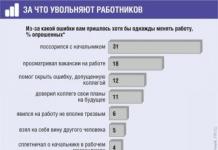An employer who reduces its workforce takes such an unpopular and economically unprofitable step for objective reasons. The main goal of the activity of any economic entity is the most optimal organization of the production process. This requires increasing the efficiency of the organization and minimizing costs. By realizing its main goal, an enterprise can make changes in the organization of labor and production. Thus, the reduction in the staff of the enterprise is caused by the impossibility of maintaining the terms of employment contracts with employees due to the objective nature of intra-organizational changes.
These changes can have both an internal reason: cost reduction and intensification of production, and an external one: changes in price conditions, devaluation of the national currency, a decline in demand for goods or services produced. The relevance of the topic of employee reduction is increasing at the present time, which is characterized by the whole complex of the above negative factors in the external environment of the enterprise.
An employee of any organization is relatively protected from arbitrary actions of the employer by legally established procedures that the employer is obliged to follow in the event of staff reduction. When deciding to go through with the downsizing procedure, the employer suffers financial losses and faces numerous organizational problems.
Establishing a part-time working day or week
In cases where the production process requires a change in the terms of the employment contract with the employee, which may lead to a reduction in staffing, a possible alternative to dismissal of employees is the establishment of part-time or part-time work. Thus, the legislator provides guarantees to employees who could potentially be fired due to layoffs to continue working at their enterprise.
The employee must write a corresponding statement if he agrees to:
- Part-time work.
- Reduced wages.
Staff reduction
The actual reduction of people at the enterprise must necessarily be preceded by a reduction in staffing. The decision to downsize must be justified by the fundamental impossibility of carrying out the production process in accordance with the existing staffing schedule.
The employer is obliged to think carefully about the structure of the new staffing table, since he will not be able to restore deleted staffing units.
The expediency of the decision to reduce staffing must outweigh all other benefits received by the employer from the vacant jobs.
Notification of layoffs
 If the decision to reduce staffing is made, then:
If the decision to reduce staffing is made, then:
- The administration of the enterprise compiles lists of positions and corresponding persons who are subject to dismissal.
- The head of the organization issues an order to dismiss employees due to staff reduction.
- Each employee must be notified of his dismissal in writing.
The employee must mark the notice as read with a date and signature. Notification of the employee can occur at any time, but not less than two months before the actual dismissal. For seasonal workers, as well as those working under an employment contract concluded for a period of up to two months, this period is reduced to 7 and 3 days, respectively.
The employer is also obliged to notify the employment service about redundant employees.
Offer to transfer to another job
The employer is obliged to use possible means to prevent the dismissal of an employee. One such means is to offer the employee whose position has been reduced to move to another job in the same organization or in other organizations owned by the same employer. The proposed vacant position must correspond to the employee’s qualifications, health and capabilities, but may be lower paid.
The employee has the right to agree with the offer or refuse it by writing a statement about it.
Preferential rights in case of reduction
When deciding on specific employees to be laid off due to redundancy, the employer is limited by regulatory guidelines distinguishing between employees who cannot be made redundant in principle and employees who have a preferential right not to be made redundant.
It is prohibited to dismiss the following categories of employees due to staff reduction:
- Pregnant women.
- Women with children under 3 years of age, as well as any person raising a child under 3 years of age in the absence of a mother.
- Single mothers raising children under the age of 14, as well as any person raising this category of children in the absence of a mother.
- Single mothers with a disabled child under the age of 18, as well as any person raising this category of children in the absence of a mother.
- A parent (legal representative of a child) in whose family three or more children are being raised, with one child under the age of 3 or a disabled child under the age of 18, if the second parent is not employed.
The following categories of employees have a preferential right not to be dismissed when staffing is reduced:
- Employees with higher qualifications and labor productivity.
- Employees with two or more dependents.
- Employees who are the sole breadwinners in their families.
- Employees who have suffered an occupational disease, injury or injury.
- Employees who received disabilities in combat.
- Employees who improve their qualifications at the direction of the employer.
The listed categories of employees are enshrined in the Labor Code. In addition to them, local regulations and the employment contract may stipulate other categories of employees who have a preferential right not to be dismissed when staffing is reduced.
 Severance pay is compensation to an employee for early termination of an employment contract. The conditions and amount of severance pay may be reflected in the employment contract. Otherwise, the general rules enshrined in the articles of the Labor Code apply.
Severance pay is compensation to an employee for early termination of an employment contract. The conditions and amount of severance pay may be reflected in the employment contract. Otherwise, the general rules enshrined in the articles of the Labor Code apply.
The purpose of severance pay is to provide financial support to the dismissed employee in the first month after dismissal, as well as for the month following it if the employee is not employed. In the first case, severance pay is received on the employee’s last working day. In the second case, at the place of former work, the dismissed employee is required to present a work book confirming that the person does not have a job at the moment.
If it is impossible to find a job, benefits will be paid for the third month after dismissal if there is a certificate of registration with the employment authorities and a certificate confirming the fact of non-employment at the time of applying for benefits.
There are categories of workers who can count on payment of benefits from employers within a 3-month period upon presentation of a work book confirming lack of employment:
- Those laid off due to staff reduction from enterprises in the Far North or equivalent areas.
- Those laid off due to staff reduction from enterprises in territories where regional bonuses to wages apply.
- Dismissed due to staff reduction from enterprises of closed administrative-territorial entities.
In addition, the Labor Code provides for a reduction in severance pay in the event of dismissal due to staff reduction to two-week average earnings for the following categories of employees:
- Seasonal workers.
- An employee who refused to be transferred to work in another location.
- An employee who refused to continue working due to changes in the terms of the employment contract.
Calculation of severance pay and benefits for the period of employment is carried out as follows. First, the employee’s average daily earnings for the last year are determined: the total amount of payments, including bonuses and other wage payments, is divided by the number of working days in the accounting year. Next, the resulting number is multiplied by the number of working days in the period for which the benefit is paid.
Among other methods of terminating an employment contract, dismissal due to reduction stands out. The fact is that among other types of dismissal provided for by the Labor Code (Labor Code of the Russian Federation), this is the most labor-intensive, but at the same time, perhaps, the most guaranteeing compliance with the rights of the employee.
Tom, what an employee and employer need to know when reducing staff, I dedicated this article.
The dismissal of an employee due to staff reduction is included in Article 81 of the Labor Code of the Russian Federation, which considers all cases when an employment contract is terminated by the employer.
○ Dismissal due to staff reduction.
✔ Labor Code on dismissal due to staff reduction.
Article 81 of the Labor Code of the Russian Federation combines both cases of dismissal for absenteeism, violation of discipline or labor protection measures, and cases when an employee quits, although he is not guilty of anything (these include, in addition to layoffs, liquidation of an organization, for managers and their deputies and chief accountants - change of owner of the organization).
The Labor Code of the Russian Federation does not decipher the difference between staff reduction and staff reduction. In practice, the difference is also insignificant and consists only in the fact that when the number of employees is reduced, the position in the staffing table is retained, but there will be fewer workers in it (for example, instead of three managers, there will be only one left in the department).
When staffing is reduced, a specific position is completely excluded from the schedule (for example, the position of a personnel officer is abolished at an enterprise, and his duties are transferred to an accountant).
✔ Who can and cannot be laid off?
Despite the fact that the reduction in the number or staff of employees depends entirely on the initiative of the enterprise management, the law provides for certain benefits for a number of categories of employees.
I'll tell you more about them below. For now, I will say that when reducing there is a rule about preferential retention at work. Art. 179 of the Labor Code of the Russian Federation provides that during layoffs, workers with less qualifications and lower labor productivity should be dismissed first.
In practice this usually means that workers with less work experience are laid off first, since seniority usually implies experience.
When making reductions, the results of qualifying exams, the employee’s education should be taken into account (in the same position, an employee with a higher education will have an advantage over a colleague with a secondary specialized education), as well as the indicators achieved by each of the employees over the previous period.
The Labor Code of the Russian Federation and other acts also require that the following employees have priority when remaining at work:
- Having disabled children.
- Single mothers and fathers.
- The only breadwinners.
- Suffering from injury or occupational disease received at this enterprise.
- Disabled war veterans.
- Heroes of the USSR and the Russian Federation, holders of the Order of Glory.
- Victims of the Chernobyl disaster and the Semipalatinsk tests.
- Improving qualifications in the direction of the organization, combining training with work.
- Employee inventors (oddly enough, the USSR Law “On Inventions in the USSR” in this part is still in force).
In addition, some employees cannot be dismissed by the employer at all except at their own request, by agreement, or for committing an offense.
In relation to layoffs, in addition to regular beneficiaries, members of trade union leadership at least below the shop level cannot be dismissed.
It is prohibited to dismiss elected representatives of a collective of employees who participate in resolving disputes with the employer.
✔ The main reasons for the reduction.
The law does not directly establish in what cases an employer has the right to reduce the number or staff of employees.
The Constitutional Court of the Russian Federation, in its ruling No. 867-О-О dated December 18, 2007, established that this is the right of the employer in cases where economic necessity requires it.
However, in turn, the Supreme Court of the Russian Federation, by ruling No. 19-B07-34 dated December 3, 2007, introduced the rule that in the event of a dispute, the court has the right to verify the need and validity of the reduction.
Thus, an employer who wishes to take such measures must order about the reduction, indicate the exact reasons for the dismissal.
As a rule, the reasons forcing workers to be laid off are:
- Low profit of the enterprise and the inability to pay salaries to the previous staff.
- Low efficiency of the previous staff and the presence of positions that are not needed.
- Changes in technology or production organization, in which some workers are unclaimed.
✔ The necessary conditions.
Dismissals of employees due to reductions are possible provided that the employer meets a number of conditions
- Full and strict compliance with the reduction procedure provided for by law.
If the enterprise previously concluded collective agreements with employees, or the employment contracts of those being dismissed contain additional guarantees upon dismissal, these must also be observed. - Justification for dismissal.
As already mentioned, in the event of a dispute, the court has the right to check whether the dismissal was justified economically and organizationally. - Employment service notification.
This point is worth highlighting separately, since some employers manage to completely forget about this requirement, as a result of which they are then forced to pay fines and pay employees for forced absenteeism.
✔ Procedure, procedure and rules for dismissal due to reduction.
Reduction of staff for any enterprise is a rather complicated procedure, and violation at any of its stages is fraught with a fine or legal proceedings for the employer.
Dismissal must be done in the following order:
- The management of the enterprise issues an order on the planned reduction at least two months before the employee is to be dismissed (Article 180 of the Labor Code of the Russian Federation). Each of the employees subject to dismissal is personally warned that a reduction is expected and, upon signature, reads the text of the order. However, an order to reduce staff should not be confused with an order to dismiss a specific employee - such orders are issued much later, when the deadline for dismissal approaches.
- For employees who are subject to layoffs, the management of the enterprise is obliged to offer any other position that meets the qualifications of the dismissed employee. It should be remembered that offering another job is not a one-time action: the employer is obliged to notify those being dismissed about vacancies opening at the enterprise right up to the termination of the employment contract. The employee is obliged to either accept the offer and continue working in another position, or refuse - and the refusal must also be recorded in writing, dated and signed by the employee.
- The employer notifies the trade union organization, if one exists at the enterprise. The notice period is the same as for employees, but if a mass layoff is planned, the union should be notified not two, but three months in advance. This rule was established by the ruling of the Constitutional Court of the Russian Federation. In turn, the trade union must express its opinion on the dismissal within seven days. If the trade union does not agree to layoff workers, then by law positions must be agreed upon within three days. If, in this case, no agreement was reached, the employer has the right to dismiss workers, but the trade union can appeal this decision to the Federal Labor Inspectorate (Rostrudinspektsiya). The inspectorate, in turn, may recognize the dismissal as illegal and demand that the dismissed person be reinstated at his previous place of work with payment. compensation and for forced absenteeism. The decision of the Rostrudinspektsiya can be appealed by the employer in court.
- In addition to the trade union, the employer also warns the employment service within the same period of time (two, in case of mass layoffs – three months).
- If within two months the employee does not agree to any of the vacancies offered to him, the employer issues a dismissal order due to staff reduction. The order is usually issued on the unified T-8 form. In this case, the employee is issued a work book, is paid a salary for the days worked in the last month of work and compensation for unused vacation days (depending on the time worked since the last vacation). The most important thing is for the employee, in accordance with Art. 178 of the Labor Code of the Russian Federation, severance pay is paid. Its amount is not less than the average monthly salary, but according to an employment contract or collective agreement with employees, the benefit can be increased.
- If an employee is registered with the labor exchange after dismissal, but is not employed, the former enterprise continues to pay him the average monthly salary for two months (but with the deduction of the severance pay already received).
- If the employee agrees, he can resign due to reduction before the expiration of the two-month period. In this case, the employer pays him, in addition to severance pay, also a salary for the time not worked between the day he actually quit and the day he was supposed to quit according to the employer’s plan. In addition, the employment contract or collective agreement may provide for other payments in case of staff reduction.
- Order on planned dismissal due to reduction - at least two months in advance;
- Warning to the employment service and trade union organization (if there is one at the enterprise) - no less than two months, in case of mass dismissal - no less than three.
- The deadline for paying wages for the part of the month worked, compensation for unused vacation and severance pay is no later than the day of dismissal.
- The payment period for the average salary for an employee registered with the employment service but not employed is up to two months.
Violation of these deadlines can lead to a fine for individual entrepreneurs - up to 50 minimum wages, for legal entities - up to 500 minimum wages.
Who cannot be laid off when reducing staff, and who should be retained at work as a matter of priority - this is discussed in our article. Let's consider the lists of preferential categories, the terms and procedure for applying the norms in practice.
You can’t fire someone due to layoffs or you have a preferential right to stay: what’s the difference?
Who cannot be fired due to staff reduction? Many people know that there is a preferential category of those who cannot be laid off when reducing staff under any circumstances. These are, for example, pregnant women (Article 261 of the Labor Code). The unit occupied by such an employee cannot be excluded. We will not recommend dismissing a pregnant woman “at her own request” during staff reductions, because The dismissal of an employee under duress by the employer can be challenged in court.
Differences between them:
- The advantage is determined only when the number is reduced, and a complete ban applies to any type of reduction. Read more about the types and some design features in the article on the website “Order to reduce the number and staff - sample”.
- The advantage does not apply in all cases. For example, if all the employees occupying the positions being reduced are family members, they will be laid off by reduction, using different criteria.
- Immunity from dismissal means the obligation to maintain a position (unit) on the staff; the presence of employees with preferential rights does not oblige the employer to change plans to reduce numbers or staff.
Let's take a closer look at the deadlines, the procedure for determining the preferential right to remain at work and applying the ban on layoffs.
When and how the dismissal ban and redundancy benefits apply
The above norms of the Labor Code of the Russian Federation are applied when preparing an order to amend the staffing table (to reduce staff and/or number) in the following way:
- Positions that cannot be reduced due to their occupation by preferential categories of workers are determined (Article 261 of the Labor Code of the Russian Federation). These include:
- pregnant woman;
- mother of a child under 3 years of age;
- single parent of a disabled child or a child under 14 years of age;
- the sole breadwinner of a disabled child under 18 years of age or a child under 3 years of age in a family with 3 or more young children, if the other parent does not work.
- When reducing the number of employees, i.e. reducing the number of staff units for one position, a procedure for determining the preferential right to remain at work is planned (if a position is excluded, this is not necessary, see the appeal ruling of the Supreme Court of the KBR dated April 26, 2017 in case No. 33 -487/2017). As a rule, a commission is formed for this purpose. The composition of the commission can be approved by the same or a separate order.
IMPORTANT! The creation of a commission to determine the preemptive right of the Labor Code of the Russian Federation is not provided for. The determination can be made by the head of the organization or the official designated by him alone. The inclusion of a trade union representative in the commission is also not provided. However, the opinion of the trade union must be taken into account when dismissing its members on the basis of Art. 82 Labor Code of the Russian Federation.
Let's consider the procedure for determining the benefits of downsizing.
The procedure for determining the preemptive right
According to Art. 179 of the Labor Code of the Russian Federation, employees with higher labor productivity (in terms of quantity and quality of results) and qualifications have a preferential right to remain at work. Both parameters are determined on the basis of accounting documents and certification results (you can learn about the procedure for preparing and conducting it and recording the results from the articles in the “Certification” section), an independent assessment of qualifications (Article 196 of the Labor Code of the Russian Federation) or educational documents. Longer work experience is not a similar circumstance (see the appeal ruling of the Bryansk Regional Court dated December 19, 2017 in case No. 33-4999/2017).
If the indicators are equal, the following have an advantage:
- family worker with 2 or more dependents;
- sole breadwinner;
- an employee who received a work injury or occupational disease while working for this employer;
- disabled during military operations to defend the country;
- an employee who improves his qualifications in the direction of the employer without interruption from work;
- a representative of another category provided for by federal laws (for example, Article 21 of the Law of the Russian Federation “On State Secrets” dated July 21, 1993 No. 5485-I) or a collective agreement (you can learn about this document from the material “Collective agreement - mandatory or not?”).
The results of determining preferential rights are documented in a protocol of the commission or a decision (order) of the head or an official authorized by him.
Thus, it is impossible to reduce staff positions occupied by employees who have complete immunity against dismissal - pregnant women, etc. (Article 261 of the Labor Code of the Russian Federation). When reducing the number of employees, more qualified and productive employees should be retained at work, and if the corresponding indicators are equal, socially significant categories provided for in Art. 179 of the Labor Code of the Russian Federation (family with 2 children, etc.).
The legislation of the Russian Federation protects the rights of citizens who are socially vulnerable. This concerns not only the payment of various benefits, the provision of benefits, but even the protection of their interests in the event of layoffs or layoffs. Thus, there is a list of categories of employees who are not subject to dismissal.
Who can't be fired?
Based on articles of the Labor Code of the Russian Federation 256 (part 4) and 261, first of all, categories of citizens protected from dismissal include:
- pregnant women, regardless of the stage of pregnancy;
- women raising a child under 3 years of age;
- single mothers raising a child under 14 years of age;
- single mothers raising a disabled child;
- employees with three or more young children, provided that the second spouse does not work.
Employees who are members of a trade union can be dismissed only after agreement with the primary organization, in accordance with Article 83 of the Labor Code of the Russian Federation, Part 2. It is prohibited to dismiss an employee due to reduction if he is on vacation or on leave.
Please note that the restrictions apply only to the case when the organization reduces staff or liquidates a department. If the enterprise is completely liquidated, these categories of citizens will also be dismissed.
Employees with benefits
There is another list of categories of citizens who do not have the right to dismissal; more precisely, they refer to the list of workers who must remain in their jobs, if available. The list of citizens is fixed in Article 179 of the Labor Code of the Russian Federation.
These include:
- Employees with the highest labor productivity, that is, those employees who, within the specified time frame, perform more volumes of high-quality work than others.
- Employees with a higher level of qualifications. To confirm this, the employee can provide:
- certificate of completion of advanced training courses;
- results of certification carried out earlier;
- characteristics of superiors;
- absence of errors and shortcomings in work;
- receiving bonuses and incentives.
- Availability of additional skills:
- PC ownership;
- Foreign language skills.
If several workers have equal qualifications and labor productivity, preference should be given to:
- People who are married and have two or more dependent people.
- Married people, provided that the second spouse is unemployed.
- Employees who were injured or have an occupational disease at the enterprise.
- Disabled people from WWII or combat who were injured while performing military duty.
- Employees undergoing on-the-job training at the direction of the employer.
Please also note that this list is relevant only for the position that the person held before dismissal. For example, if an employer decides to liquidate the statistics department, then the specialists working in it can apply for the position of secretary equally - regardless of productivity and qualifications.
Do minors have privileges when staffing is reduced?
The rights of persons under 18 years of age are protected by law. Thus, according to the provisions of Article 269 of the Labor Code, employers are prohibited from dismissing minors without the consent of state authorities. Therefore, the employer must initially contact the inspectorate to obtain permission to dismiss such an employee. As a rule, based on the protection of children's rights, authorities give a negative response to such a request, recommending dismissal of another applicant.
What to do if an employee’s rights are violated?
If an employee's rights are violated, he can go to court. In cases of dismissal, disputes take about a month from the day the employee was given a dismissal order or work book. It should be noted that if within one month from the date of dismissal it was not possible to go to court for a good reason, for example, due to illness, the case will still be considered.
Video: Who is prohibited from being laid off?
You will learn more about the categories of citizens who have privileges during layoffs from the video, in which an expert in labor and personnel records management will also tell you what an employee should do if he was on vacation at the time of layoffs:
Laws and business in Russia
Who cannot be laid off (dismissed) by law?
Who cannot be fired by law and who enjoys special rights in the event of staff reduction?
People should know their rights, but each case of dismissal must be considered individually. After all, sometimes it’s easier to quit and receive appropriate compensation from the state and find a new job.
Who are they, the workers who cannot be fired?
Employees who are temporarily disabled and who provide the employer with sick leave, on the basis of Article 81, Part 6 of the Labor Code of the Russian Federation.
Employees who are on any type of leave, be it main leave or leave without pay, as well as women who are on maternity leave. This is regulated by Article 256, Part 4 of the Labor Code of the Russian Federation.
Women who are pregnant, except in cases where the enterprise is subject to complete liquidation. Based on Article 261 of the Labor Code of the Russian Federation.
Guardians, foster parents, single mothers (men who are raising a child without a mother) who are raising children under 14 years of age or disabled children under 18 years of age. And also mothers who raise a child until he reaches the age of three. The basis is Article 261 of the Labor Code of the Russian Federation. An exception to this law is the commission of a crime proven in court or the complete liquidation of the enterprise.
Workers of trade unions. The basis is Article 81 of the Labor Code of the Russian Federation, according to paragraphs: 2,3,5.
Workers who are authorized by the collective to conduct collective bargaining.
Persons who directly participate in collective disputes.
If these categories of people were fired, all the same, a positive court decision on their reinstatement in the workplace with full compensation for forced downtime and legal costs occurs almost instantly and automatically.
Workers with legal benefits
This is clearly stated in Article 179 of the Labor Code of the Russian Federation. When one employee is laid off out of two, an employee with less productivity and less qualifications is fired.
However, if two employees occupy the same position and have the same qualifications, then the following citizens have benefits without losing their jobs:
- Employees who care for two or more dependents.
- An employee who is the sole breadwinner in the family.
- A worker who has contracted an occupational disease or been injured at a given enterprise.
- Persons who improve their qualifications at a given enterprise, without interruption from production, in the direction of the employer.
- Citizens belonging to the category of disabled people who received disabilities in combat operations to defend the Fatherland.
On the one hand, one can understand an employer who is trying by all means and forces to keep his business afloat (including by reducing the number of employees). On the other hand, who will understand the workers themselves? Moreover, in an effort to reduce wage costs, employers often commit the most flagrant violations.
Note for pregnant women
According to the direct instructions of the Labor Code of the Russian Federation, pregnant women are among those workers who cannot be laid off (Part 1 of Article 261 of the Labor Code of the Russian Federation).
Despite the fact that not only according to the Labor Code, but also according to all moral laws, pregnant women have the right to count on the most attentive and careful treatment, a simple verbal statement that you are pregnant is a weak guarantee against layoffs.
We need documents. In the early stages, pregnancy is confirmed by a certificate from the antenatal clinic or from another medical organization that has registered the woman (clause 22 of the order of the Ministry of Health and Social Development of Russia dated December 23, 2009 No. 1012n).
There is no single form for such a certificate, and, as a rule, antenatal clinics and medical institutions simply issue a written certificate that contains the necessary details - the name of the consultation, full name and position of the doctor who issued it, signatures, seals and stamps.
In later stages of pregnancy (more than 30 weeks, and in case of multiple pregnancy - 28 weeks), the employee’s pregnancy is confirmed by a certificate of incapacity for work (clause 46 of the Procedure for issuing certificates of incapacity for work, approved by order of the Ministry of Health and Social Development of Russia dated June 29, 2011 No. 624n).
A certificate of incapacity for work for pregnancy and childbirth is issued by an obstetrician-gynecologist, in his absence - by a general practitioner (family doctor), and in the absence of a doctor - by a paramedic.
The law does not require a woman to notify her employer that she is pregnant. Moreover, in a short period of time a woman may not know about it at all. Nevertheless, if on the day of dismissal the woman was pregnant (and this fact is confirmed by relevant documents), then the court will declare the dismissal illegal.
Judicial practice does not attach importance to the fact that the employer is aware or unaware of the pregnancy of a woman who is being laid off: Part 1 of Article 261 of the Labor Code of the Russian Federation contains an unconditional ban on the dismissal of a pregnant employee.
By the way, competent employers (and there are an overwhelming minority of them) include a clause in the notice of layoff stating that if the employee provides documentation of pregnancy, she will not be fired.
If the employee is a single mother
The Labor Code of the Russian Federation prohibits layoffs for single mothers raising children under the age of 14 (Part 4, Article 261 of the Labor Code of the Russian Federation). Therefore, the mother must at least have a document about the child’s age - a copy of the birth certificate. However, this will not be enough for the child’s mother to be considered a single mother.
The problem is that “single mother” and “single mother” are everyday concepts, and they are not included in the legislation.
The clarifications of the Supreme Court of the Russian Federation fill this gap. In the Review of Legislation and Judicial Practice of the Supreme Court of the Russian Federation for the first quarter of 2010 (approved.
Resolution of the Presidium of the Armed Forces of the Russian Federation dated June 16, 2010) states that:
To recognize a mother as single, it is necessary that the column “Father” in the birth certificate is not filled in (or information about the child’s father was entered according to the mother’s words - in this case, a certificate from the registry office is submitted on the grounds for making an entry in the birth certificate);
The child's mother must not be married. This is confirmed by a copy of the passport.
A divorced woman cannot be considered a single mother, provided that the child’s father is alive, takes part in his maintenance (pays alimony) and is not deprived of parental rights (Decision of the Supreme Court of the Russian Federation dated 07/09/10 No. 81-B10-6).
If a single mother is raising a disabled child, she cannot be laid off until the child reaches 18 years of age (a certificate from a medical and social examination is required).
Availability of dependents
If labor productivity and qualifications are equal, preference in remaining at work is given to:
family - in the presence of two or more dependents (disabled family members who are fully supported by the employee or receive assistance from him, which is their permanent and main source of livelihood);
persons in whose family there are no other independent workers;
employees who received a work injury or occupational disease while working for this employer;
disabled people of the Great Patriotic War and disabled people fighting in defense of the Fatherland;
employees who improve their qualifications in the direction of the employer without interruption from work (Article 179 of the Labor Code of the Russian Federation).
A dependent is a disabled family member who is fully supported by the employee or receives assistance from him, which is his constant and main source of livelihood (Part 2 of Article 179 of the Labor Code of the Russian Federation).
A dependent may be the employee’s spouse, parents, as well as other relatives (Article 2 of the RF IC).
An employee who has children may also benefit from preferential employment rights, since children are dependents by law.
However, employees who have at least two dependent children have a preferential right to remain at work (Article 179 of the Labor Code of the Russian Federation). If at the time of layoff at least one of the employee’s children is already 18 years old, then he cannot be considered a dependent.
In this case, certified copies of the children's birth certificates will be required.
If, for example, the dependent is the employee's spouse, then you may need to:
ITU certificate of disability;
spouse's work record;
certificate from employment authorities.
Single father
Workers raising a child without a mother have some immunity from layoffs. According to the clarifications of the Supreme Court of the Russian Federation (Review of legislation and judicial practice of the Supreme Court of the Russian Federation for the first quarter of 2010, approved by the resolution of the Presidium of the Supreme Court of the Russian Federation dated June 16, 2010), an employee can be recognized as such, regardless of the specific case, as a result of which the child’s mother stopped caring for him care.
In practice, it is considered that an employee is raising a child alone if the child’s mother:
died (declared dead);
deprived of parental rights;
limited parental rights (for the period of restriction);
declared missing;
recognized as completely incompetent or partially incompetent;
is serving a sentence of imprisonment;
is in custody;
is suspected of committing a crime;
avoids raising a child or protecting his rights;
refuses to take his child from an educational or medical institution;
The mother does not have the opportunity to personally raise and support the child due to her health condition.
Employees raising disabled children without the participation of their mother are not subject to dismissal until these children reach the age of 18.
Finally
So, before you go into conflict with management, you need to clearly find out whether you really belong to the “protected” category. You can try to avoid decisive action for a while by declaring your “immunity” verbally, but you should understand that the employer has the right to demand supporting documents. This is not only a right - it is also an employer’s obligation, since unjustified provision of benefits to one employee may result in a violation of the rights of another employee who is entitled to them.
IMPORTANT:
Ideally, before downsizing, the employer should find out which of its employees cannot be dismissed on its initiative. And here there is an important point: unfounded statements that you have certain social privileges will suit few people. Maybe you can hold out on your word of honor for some time, but if a dispute arises, which quite possibly will be heard in court, you will not be able to prove the illegality of your layoff.
According to the author, a single mother remains such after marriage - until the new spouse adopts a child. According to the RF IC, spouses are obliged to take care of each other and financially support each other (Article 89), as well as support their minor children (Article 80 of the RF IC). Therefore, the new spouse is not obliged to support a child whose father he is not. Unfortunately, it was not possible to find judicial practice on this issue.
Employees raising young children are not subject to dismissal until the child turns 14 years old.
Marina ASTAPENKO, Lawyer


















